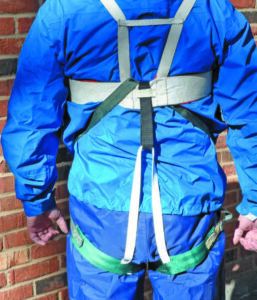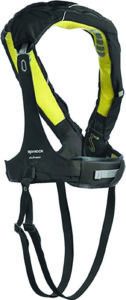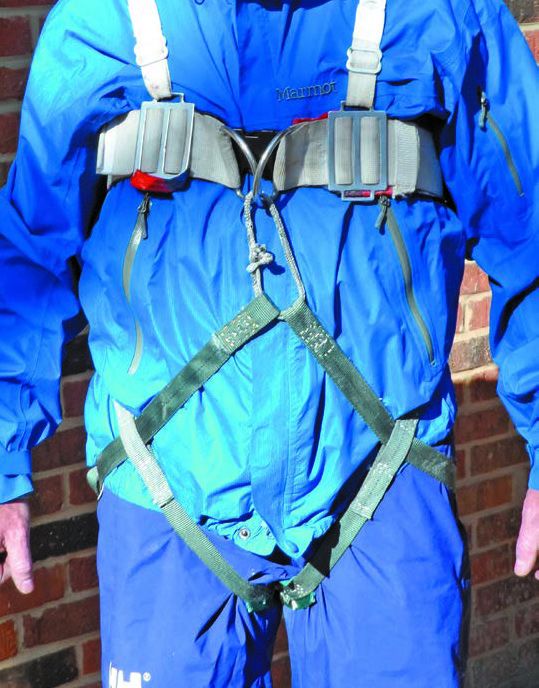Recent fatalities involving racing sailors raised a long-simmering concern we’ve had regarding the harness and tether design, and the shortcomings of current design when used aboard boats that cruise at double-digit speeds. Although these harness and tethers might keep a sailor from going overboard, the impact loads transmitted via the harness and tether can exceed what the human body can endure (see Building a Custom Safety Tether, PS December 2017).
Unless snugged uncomfortably tight, inflatable PFD/harnesses can slide up when under load, even so far as to allow the wearer to slip right out of the harness. One solution is to add a strap between the legs to hold the harness in place.

These straps not only prevent a harness or ah from sliding up, but also hold the harness down while a person is getting dragged through the water. Ideally, they might absorb some of the impact if a sailor falls over the rail, but preventing injury in a fall is not their primary mission.
The focus of any current sailing harness design is the chest harness. Interestingly, the International Standards Organization, the U.S. Occupational Safety and Health Administration and other standards organizations have banned chest harnesses for any purpose-including positioning. Several studies have determined that even hanging for 30 seconds on a chest harness can cause permanent injury, and that any vertical impact is unthinkable.
Forensic evidence collected by testing carabiners and evaluating information from the recent Clipper accident involving Simon Spiers (see Safety Tethers Under Scrutiny, March 2018) makes it clear that a sailor thrown over the railing will feel an impact load of at least 1,000 pounds, get the wind knocked out of him, suffer debilitating muscle spasms, and potentially break a few ribs.
Investigations into of other fatal accidents, including the loss of Glynn Charles during the Sydney-Hobart 1979 race and Richard Sharp during a knock down in 1983, concluded that the victims were likely subjected to harness forces over one ton. For this, you need a harness that can distribute the load.
The Crotch Strap
Many PFD/harnesses come with single crotch strap. A pair is better and are gaining acceptance among ocean racers. Some evolved to a pair of thigh straps, or leg loops, as climbers call them. However, these leg loops have a reputation for sliding down the leg towards the knee when you sit or squat.
All of these leg loops use plastic buckles and clips that are not rated for impact loads. According to the manufacturers, these leg loops are designed only for jumping in the water from 10 feet with an inflated PFD, with no tether attached.
Climbing seat harnesses are well proven for climbing the mast and certain foredeck tasks, where they provide adequate support and allow the user to lean far to the side to reach for something. However, these seats are dangerous as a deck harnesses because the attachment point is too low and they will nearly break you in half if you are towed through the water beside the boat.

Industrial harnesses are bulky and heavy, are generally designed for attachment between the shoulder blades, and have metal hardware that can scratch decks. They can restrict movement and orient the wearer in an awkward position.
Keeping the needs of a sailor foremost in our minds, we developed a new leg loop design. The design will fit any chest harness without modification, allow full freedom of movement, and will not shift or allow the leg loops to fall down.
What We Tested
We tested single and twin crotch straps made from 1-inch webbing, Mustang Leg Straps, and our own leg loop design.
How We Tested
We compared comfort, construction, and cost and then put two designs through physical tests while worn by one of our testers. We tested a standard climbing seat harness designed for arresting falls, and our own new design. The test was a simple drop through a series of falls up to a distance of six feet on a single climbing rope. For safety reasons, we did not use a chest harness alone for any drop tests.
Observations
The unvarnished truth about leg straps is that narrow 1-inch webbings in the crotch area is more than unpleasant in a fall. In fact, the damage that it imparts in such a vulnerable area can require hospitalization. Climbers are well aware of this anatomical truth.
Hang time
As expected, the leg loops do relieve pressure when suspended. When we added Mustang Leg Straps to a 70 millimeter chest harness band, the testers ability to remain suspended and relatively pain free increased from 15-20 seconds to a few minutes.
However, unless we wore the leg straps uncomfortably tightly, when we sat, squatted, and scooted on deck, they slid down the leg, and behind the knee. At that point, we couldn’t stand up.
By virtue of being attached to the sides rather than to the harness D-ring, leg straps are not positioned well to transmit any of the tether load. Finally, the pull is directed against the vulnerable inner thigh, where they can damage nerves and pinch off the femoral artery.
A single crotch strap gave us a 50/50 chance of coming down hard on something tender. Worn while floating in the water, a single crotch strap is not a threat. You can shift the strap to alleviate most of the pinching. In a fall, a single crotch strap-if it held (most would not)-could cause serious pain.
Testers found that the single crotch strap carried very little of the tether load-and any that was transferred was transferred to parts of the body that are nearly as vulnerable as the chest area. Single crotch straps did not advance to drop testing.
Pairs of crotch straps, such as those used on the Spinlock Deckvest, are much better because the attachment points are separated, guiding the straps to the inner thigh. However, these straps can still put painful pressure on vulnerable areas depending on the clothing worn. Twin straps are adequate in the water with a PFD, and they did yield an acceptable hang time, but they did not advance to drop testing. There was no chance of finding volunteers.
Finally, all of the available leg strap and crotch strap designs use plastic buckles and clips that are not rated for any force. In fact, according to the manufacturers, they are rated only for jumping in the water from 10 feet with an inflated PFD, with no tether attached. Given their ergonomic shortcomings, perhaps this is just as well. Among the current designs, we rate the twin crotch straps used on Spinlock harnesses as the best commercial alternative, but in our view, these are still unacceptable.
With the new leg loop design we could hang for greater than 10 minutes with only limited discomfort. There was no chance of catching something tender.
We also tested wider leg loops. We tried adding padding, which increased the hang time, but was less comfortable when worn all day. The seat harness allowed hang times up to 20 minutes, but we wouldn’t want to walk around in one all day.
Falls
We set up 10 feet of 10 mm UIAA single dynamic climbing rope and took a eighteen falls of up to 6 feet, with measured impact forces ranging from 450-850 pounds on both the new leg loop design and a conventional seat harness. These falls were cumulative sufficient to severely damage two UIAA fall-rated climbing ropes, a good measure of the severity of the falls.
Instead of using a mannequin, as standards allow, we did what climbing gear companies do and tested with a real person. (A mannequin would pass the test with a noose around his neck without complaint.) We wanted to measure real world comfort, in foul weather gear, so we used Practical Sailor Tech Editor Drew Frye as a test dummy. A safety expert might say that this was a fitting designation for anyone who would willingly participate in such a test.
The test dummy reported that while the climbers seat harness was slightly more comfortable in terms of force on the thighs, the new design did a better job of protecting the spine and keeping the body erect. (Some of the falls were at angles up to 45 degrees).
Frye experienced no bruises or soreness the following day, suggesting that truly epic falls with forces above 1,200 pounds could be managed without harness-induced injury. For safety reasons we did not try this with a chest harness alone (broken ribs would be likely) or the standard leg loops (they offer little support, if the plastic parts broke, broken ribs would follow, and if the plastic parts didn’t break, that might be worse).
Comfort
Any leg loop, leg strap, or crotch strap is noticeable. However, we found this design more comfortable than existing designs in three general areas. Unlike standard leg loops on personal flotation devices, the loops on this design do not need to be worn snug to work properly. They will function fine hanging loosely with no slack. The leg loops do not fall down.
Compared to crotch straps, they are not chronically compressing tender areas. Finally, compared to standard industrial and climbing full body harnesses, our DIY harness moves with the body, never binding or restricting motion. It is as lightweight as PFD leg loops, just configured more intelligently.
All-around Function
The improved leg loop design also creates a harness that is suitable for other uses. As a rescue harness, it provides a swimmer sent in to assist an MOB with full mobility and safe hoisting.
It can be used up the mast for a short trip to clear a tangle or retrieve a halyard. To do this simply replace the soft shackle at the front closure with a screw gate locking carabiner and attach the halyard to the carabiner instead of the chest harness D-ring. This lowers the balance point just enough to improve comfort and increase mobility while suspended. Other chest harnesses must be combined with a seat harness to serve these functions.
Downsides? The advantages of twin crotch straps is that they can be put on in seconds and don’t tangle. Leg straps take a little longer. The new leg loop design is the least convenient to don. It is still relatively quick to put on and adjust, but it can get tangled during storage.
If you label the right and left straps and hang the harness with the leg loops and fasteners connected, you greatly reduce the risk of tangling. If you store the harness in this fashion, donning is relatively easy: You simply lay out the harness, sit on the chest harness band and put your legs through the loops like pulling on pants.
You then stand, pull the chest harness up and over your shoulders. Finish by attaching the front closure and adjusting the leg loops if needed, though for a single wearer this is generally unnecessary.
Conclusions
We don’t pretend to have found the perfect solution, but we do think that our design is better than what is commonly available to sailors. We have, in effect, thrown down the gauntlet, showing what is possible and practical.
The add-on leg loops we tested are only one possible direction. A chest harness could be designed specifically to compliment them. A harness/PFD combination could be designed from the ground up.
We leave it to gear manufactures to polish these ideas and bring us harnesses or PFD/harnesses that safely meet the needs of today’s sailors.






































How does this compare to an industrial fall protection harness?
It does not. Neither does any sailing deck harness. Our intent was to explain the weaknesses of current design and to challenge manufacturers to come up with something better.
For working up the mast our recommendations are big wall rock climbing harnesses and tower harnesses. Both are designed for prolonged suspension. Common OSHA fall protection harnesses will catch a fall, but if you hang for more than a few minutes they can seriously injure blood vessels in your legs. Sport rock climbing harness work, but your legs will go to sleep within 15 minutes (additional padding width on the leg loops helps).